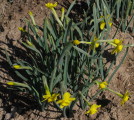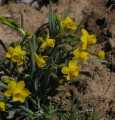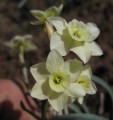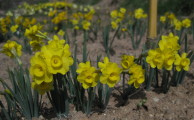I have grown and killed more than my fair share of apodanthus daffodils. For me they are the best exhibition miniatures, division 6 is too early, so it is worth taking a little trouble to grow them.
I have been most successful growing them in the field. Last season was an apodanthus year for me. After a couple of good springs and a little care they flowered prolifically such that I was able to number them and actually discard some.
Left to themselves they can form large clumps. 12/33A is calcicola x watieri and has been sitting undisturbed since about 2004. This period has included severe drought with very hot dry summers and also a couple of wet summers. There is no doubt these daffodils can be very hardy.
My original intuition was that the moisture retaining loam, naturally acidic, needed sand, but later plantings had to do without. 12/6A rupicola x (calcicola x rupicola) was planted out as a 2yo seedling in 2007 i.e. this is its 6th year undisturbed.
Under these conditions calcicola and marvieri seedlings do best. My marvieri is large and its petals incurl but, these things excused, its seedlings can have wonderful quality. 12/28A has marvieri as a pollen parent.
N. … watieri doesn’t do so well, almost none remain, but the calcicola x watieri are very robust. 12/50A is (calcicola x watieri) x watieri, also undisturbed since 2007. It is meant to be a step toward a multi-headed all white apodanthus.
12/51A rupicola x watieri has grown in the sandier soil since it was planted out in 2004 as a 2yo seedling. Although it has survived it hasn’t exactly thrived.
In the field the bulbs can be quite shallow. I have had the strong view that in pots (polystyrene boxes) the apodanthus should be grown in a light acidic soil and then lifted and kept cool and dry in summer. Leaving them cool and dry in boxes over summer has been a failure for me and hot and dry has not been good either. Potting mixes, I think, are a bit soggy compared to undisturbed soil. Interestingly, a neglected bulb in a narrow black pot and soil-less potting mix survived over last summer even though it was not particularly shaded. So for me, dry in summer is essential, but the question of baking is an open one, particularly in view of their survival in the field. My intuition tells me that they need to rest fairly shallow under undisturbed soil in the field in my climate but in places where summers are more humid and wet they will need to be lifted.
The 2012 selections have just been lifted and moved now as roots are emerging/emerged in the hope that the soil will have settled come next summer. Last year 09/2A calcicola x watieri was moved in about August, just a month or so before flowering. That, I am fairly confident, was a good practice.







Lawrence and Steve,
Thanks for your postings on the growing of species. Sounds like my best option is to lift each summer as that is the only way I could keep them dry during the summer in my area.
Lawrence, Sounds like the hybrids between those species are doing best for you. The hybrid vigor seems to have added a stronger constitution to them. Wow, some really beautiful selections. They are growing and blooming really well. Congratulations on such beautiful selections. Thanks for posting!
Larry
Lawrence, have you done much or anything with apodanthus among the standard 7s? Five or six years ago, there was some serious discussion about them in the ADS. And Steve Vinisky touched briefly on apodanthe at the 2011 convention. I for one would have liked a list of the commonly grown 7s which would be considered apodahthe? Are they the ones that often flower with just one bloom, or that might probably have qualified as an intermediate Division 2?
Loyce McKenzie
Thanks Larry,
The almost orange in the back of the last photo is calcicola, so it does well. I probably have one bulb of marvieri. Just a a few rupicola have clumped up seriously – the ones with the poorest form of course.
Hi Loyce,
I have, at most, one hybrid with main division flowers and I suspect I threw it away. A quick search on Daffseek yields the following:
Ocean Spray 7W-W Mitsch
Tweeny 12W-Y Gray
Dainty Miss 7W-GWW Mitsch
Marilynn 7W-P Koopowitz
This suggests that Tweeny should probably be in division 7.
I remember expressing a view way back that we could divide division 7 into single and multi-headed classes, but because of scaberulus and calciola we couldn’t achieve a similar result by dividing division 7 into jonquilla and apodanthus. Furthermore, hybrids between the two (and these are some of my best miniature 7’s) would be hard to distinguish as one or the other. An emerging problem, if we wanted to classify by section, is that we may have to address the issue of section juncifolia.
I sometimes have trouble deciding whether tazetta x jonquilla or x apodanthus are 7 or 8 (but am of the strong view that if a flower might fit into 2 divisions we have to choose and we mustn’t put it in div. 12). It seems to me that the boundaries are becoming more difficult and we are in a poor position to create more of them.
If you search Daffseek for div.2 flowers with jonquilla as a pollen parent you obtain a list of flowers. Similarly if you search for div.2 flowers with Hillstar and Quick Step as seed parents you obtain lists. Wherever you look there is no clear distinction between apodanthus and jonquilla hybrids in the classification system.
The over-riding principle is that we classify daffodils not by section or breeding but by their appearance on the show bench. I don’t think it is possible to find a special place for apodanthus.
That’s rather a relief!
Hi Lawrence,
Great post of much interest and really lovely flowers! Excellent, creative crosses. Thanks so much.
I do agree about the visual difficulty in separating Apodanthae on the show bench. There really are only two flower characteristics that distinguish them and they aren’t any help on the show bench. The first is fragrance. Section Jonquilla is highly fragrant. Section Apodanthae either not at all or much less fragrant. The second is that there are no known white flowers in Section Jonquilla.
There are tremendous differences between the two in their leaf structure, bulbs, tunic, etc. which are no help at a show.
On the surface, there seems to be some fertility affinity between Apodanthe and Poeticus. A huge percentage of the things listed with Apodanthe as either a seed or pollen parent have poeticus in the background. I’d dearly love to be able to ask Grant Mitsch how many crosses and how much effort it took to create ‘Dainty Miss’. Hybrids with other Sections are also represented but there are far, far fewer of them. Is this due to fertility issues? Physical timing as in late to late?
I consider myself to be NO expert in Apodanthe. I have GREAT difficulty with: N. atlanticus (killed it four times including one precious bulb sent by John Blanchard), and N. scaberulus (flowered ONE time only for three years in a row which is my best “record” and I’ve raised lots to flowering from seed). The others in the Section don’t seem to be too difficult in the raised beds outside.
Larry, rather than going to the effort of annual lifting and replanting, might a raised cover over a bed be an answer? I’m thinking here of a fiberglass cover raised up a foot or two all around the bed for air circulation which simply sheds summer rain, yet partly shades and cools.